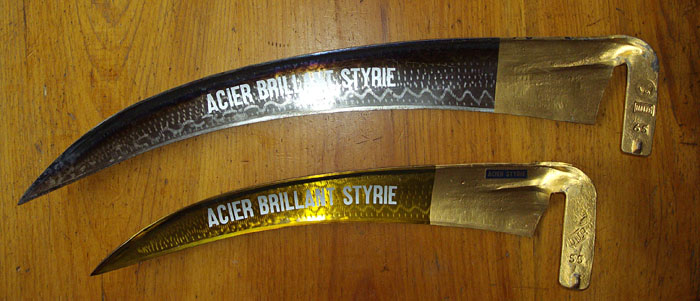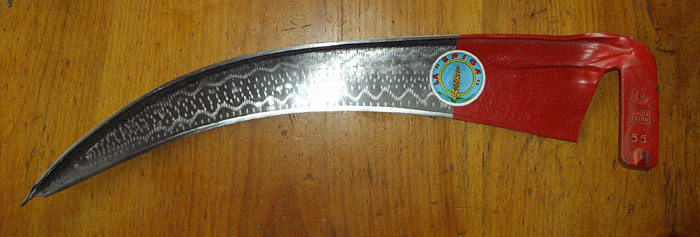
About Us
Contact Us
Events
Products
Scythe Buyers' Guide
Technical/
Instructional
Updates
Video
Home
Italian-made Scythe blades
#101, #102, #103 and #109 are of contemporary production; the rest are left over from the period between approximately 5 and 40 years ago. All, in our opinion, are fine pieces of steel to have mounted on the end of a snath. Their weight is in all the right places (meaning the necks are strong and the points light), the overall tension excellent and the workmanship beautiful.
 |
#100
65 cm. - 370g. - $74.00
Tang steepness - 28°
We had previously listed this blade as #22, but because it was made in Italy, we have now moved it to this section with its "blood family". It is of a somewhat recent production, but is one of the models now discontinued from Falci's standard program. This is the blade we used in the "brush" cutting demo and how we described it last year:
One of the patterns preferred in Turkey, where heavy blades seem to have been a taboo, this is the lightest per cm. of our listings. For that reason it may be (along with #2) the best for children. It is, however, stiffer than #2 and, although we do not recommend it as a "bush" blade, in experienced and/or sensible hands, green poplar, willow, alder, spruce, fir etc. saplings can be cut with it. All in all, I think that this sweetheart of a blade is worth its weight in precious stones...
 |
#101
SOLD OUT
70 cm. - 465g. - $80.00
Tang steepness - 22°
Along with #102 and #104 this model has been popular in Northern Italy and many other Alpine regions.
 |
#102
55 cm. - 390g - $65
65 cm. - 460g - $74 Out of Stock
Tang steepness 30°
Recent production of one of the most popular contemporary (albeit by design very old) models. Neither extremely light nor unnecessarily heavy, it is, in our view, a blade with a rather universal applicability.
 |
#103
70cm - 450g. - $77.00 - Out of Stock
75cm - 510g. - $82.00
85cm - 560g. - $94.00 - Out of Stock
90cm - 600g. - $98.00 - Out of Stock
Tang steepness: 28°
Similar pattern to our Austria-made blade #2, this is a typically "Eastern" model (Romania, Turkey, Iran, etc.) The tang, however, is too acutely hafted to function well on most common snaths. (More on this later)
 |
#104
55cm - 345g. - $75.00
65cm - 445g. - $85.00
Tang steepness: 22°
With somewhat more elevated and straighter point than was typically used in much of Italy; more of an Alpine-style model (seen here dressed in two editions).
 |
#105
55cm - 455g. - $78.00
60cm - 510g. - $84.00
Tang steepness: 30°
Why the image of a North American Native (who had no use for a scythe) would be used as a trademark is quite beyond us. Interestingly, both Austrian and German industries once did the same thing -- and on blade models which this continent never saw. This specific model is as typically Italian as the original version of lasagna. The body is rather flat, stiff and with a low point. (As explained elsewhere on this site, it is easier to cut a stubble without "steps" with a low-pointed blade than with for instance the classical Austrian pattern.)
 |
#106
60cm - 495g. - $90.00
Tang steepness: 28°
This is a special edition of nearly the same model as #105, really a collector's item. (Very limited supply).
 |
#107
55cm - 440g. - $82.00
Tang steepness: 28°
Very similar to #105 and 106, but of still older (30+ years) production.
 |
#108
OUT OF STOCK
55cm - 450g. - $65.00
Tang steepness: 28°
Dressed the same as #101, this is nevertheless a different model which, along with #109, are amongst the "ditch" blades most widely used in Italy today.
 |
#109
OUT OF STOCK
50cm - 420g. - $60.00
Tang steepness: 28°
Another Indian portrait on a more contemporary blade. Similar to #108 but a little lighter; otherwise the description above applies.
 |
#110
50cm - 300g. - $78.00 (pre 1980s make)
55cm - 350g. - $75.00 (mid to late 1980s)
60cm - 410g. - $80.00 (mid to late 1980s)
Tang steepness: 28°
 |
(click for more photos)
#111
OUT OF STOCK
70cm - 470g. - $111.00
Tang steepness: 28°
Practically the same model as #102, but approximately 40 years old. An extraordinarily beautiful as well as high quality blade. The iridescent finish (once used by Austrian makers as well) is now a thing of the past.
"A man whose mind is enlightened with a knowledge of mechanical principles, will never bend nor break a spade; his keen perception will tell him, even if he were blindfolded, when the strength of the spade is unequal to the force applied to the handle".
-- S.E.Todd, The Young Farmer's Manual, 1860
Of course, this timeless observation applies to women as well as men, and to all other tools besides spades.
Shipping rates:
Within Canada:
For one to two complete units - snaths, up to 4 blades, accessories - $40
For one to four blades and accessories: $30
Any other combinations; please contact us.
To the U.S.
$55 for one to two complete units;
$35 for one to four blades with accessories.
Any other combinations, contact us.
Overseas Estimates:
Under 1kg. and up to 80cm long: $50 for surface (6-8 weeks) and $90 for air (10 days). This rate covers a blade and ring, and possibly a whetstone. A 10kg. parcel (80cm length) is $110 by surface or $230 air. Snath shipping is prohibitively expensive: $300-400!
Contact us for a quote, or better yet, find an alternative source here.
Ordering:
All prices are in Canadian dollars.
We do not, and likely never will, accept credit cards or other forms of electronic payment. If you feel moved to bypass the corrupt banking system, sending cash in an envelope is fine. The next most expedient option is a postal money order or bank draft (for US residents: specify an 'International money order'). A personal check takes one to two weeks to clear.
Checks or money orders should be made out to Ashley Vido, (not ScytheConnection) and mailed to:
1636 Kintore Rd.
Lower Kintore, New Brunswick
E7H 2L4 Canada
OR to our mailbox in Maine -- but PLEASE send an email before mailing anything to this address, as we only check it sporadically:
26 North Street, P.M.B. 161
Presque Isle, Maine 04769
1 Jan. 2010
Modified 06 Oct. 2012